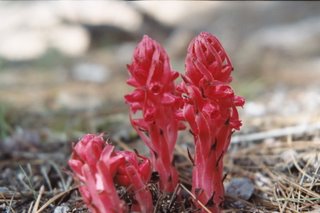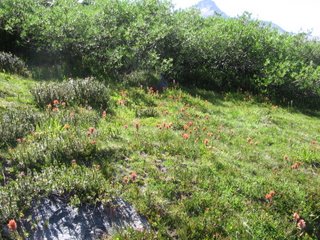
|
 |
 |
 |
 |
|
|
Wednesday, September 27, 2006The Magic of Stargazing at Glacier Point
During the summer in Yosemite National Park, astronomers gather on some weekends on Glacier Point, at 7200', far above Yosemite Valley. From Glacier Point, viewers can see Half Dome from a different angle than the commonly photographed valley view. But that is not all you can see...for on these dark summer nights, over twenty astronomers are known to gather with just as many very powerful telescopes.
During the new moon, I ventured up there, and was very much rewarded. The astronomers, some professional and some amateur, were very friendly, offering views through their telescopes. I saw many spectacular nebulae, including the Cat's Eye, Lagoon, and Omega Nebulae. The Ring Nebula was one of my favorites, looking rather like a great smoke ring in the sky. It's a planetary nebula, 2150 light years distant, which formed after a red giant shed its outer envelope. I took in the Andromeda Galaxy along with two of its satellite galaxies, all part of the Local Group of galaxies, to which our Milky Way also belongs. I saw the Whirlpool Galaxy, and thrilled to the sight of Uranus, which shone a deep blue in the telescope. But by far the most exciting part for me was seeing three asteroids. Actual asteroids -- it was a first for me, and it gives you an idea of the power of these telescopes that they can see an object only a 100 miles across as far away as Jupiter and Mars. These asteroids orbit in the Asteroid belt between our fourth and fifth planets. I saw Hebe, Eunomia and huge Ceres, the asteroid that almost became a planet a few months ago in the same movement that proposed a total of 12 planets for our solar system. As you all know, this ended up going the opposite direction, actually demoting Pluto, and reducing our planets to 8. Ceres was originally thought to be a planet in the 1800s, but was demoted itself in the twentieth century. It is now considered a "minor planet" by the new criteria put in place in August 2006. Observations of Ceres by the Hubble have hinted to astronomers that the mantle of Ceres, which wraps around its core, may consist of water ice. It was a magical time, out there under the glittering stars, peering into the expanse of the universe. posted 7:15 PM
Monday, September 25, 2006Wildflowers of the Sierra Nevadas
During my hikes in the Sierra Nevadas, I've encountered a lot of amazing wildflowers. These alpine flowers have a very limited time to bloom -- two months at most, between snows. Here are a few:
Snow Plant. This flower is only visible in June, just as the snow retreats posted 2:56 PM
Sunday, September 24, 2006Into the Backcountry Behind Saddlebag Lake
The hike in behind Saddlebag Lake in the Inyo National Forest is an incredible one. At the start it's all rock and ice at 10,000 feet. We crossed over rockslides that sounded like glass crunching and shifting under our feet. The lake stretched out before and behind us, meeting the backdrop of snowy-covered mountains.
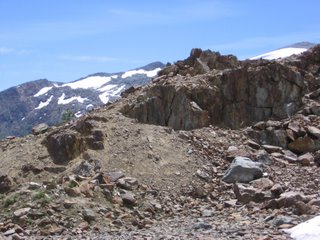 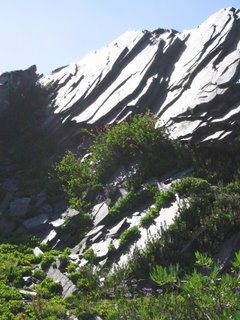 After a lengthy stretch of walking on rocks, the trail takes a turn, and the end of Saddlebag Lake comes into view, a cluster of pines at one end. With all the rain, it was lush -- an emerald fairy land of wildflowers, moss and grasses. I photographed pink and yellow columbine, bright purple wild onion, red Indian paintbrush. Granite slabs protruded from the ground, with moss and wildflowers growing off them in cascades. 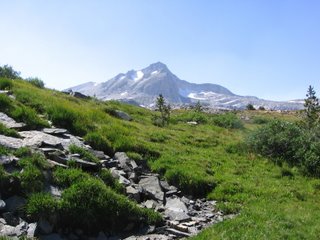 Beyond Saddlebag Lake lay another lake, sparkling in the late afternoon sun. Beyond that lay still another lake, meeting with a narrow canyon. A waterfall plunged down from a steep cliff. The high country is incredible, and from up here it's all lakes, ice, snow, wildflowers, and rock. 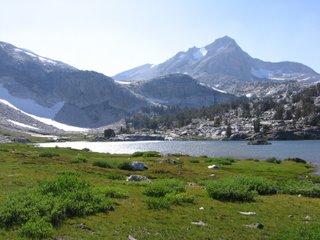 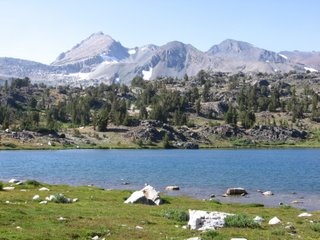 We returned to the edge of Saddlebag Lake, then crossed the rock slides once again, and descended on the eastern side of the Sierra Nevadas to see Mono Lake, home to strange tufas and spadefoot toads. 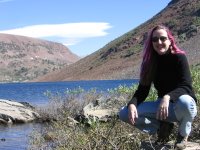 posted 4:23 PM
Sunday, September 17, 2006Looking for Pikas at Saddlebag Lake, Day 3
We drove the winding gravel road up to Saddlebag Lake in the Inyo National Forest to look for pikas. These little creatures are lagomorphs, related to the rabbit. They live in loose rock piles, or talus slopes, and use a high-pitched call to communicate. They're wonderful to watch -- bounding from rock to rock, collecting long grasses until their mouths are absolutely stuffed. Then they pile the grass in the sun, forming little haystacks. Pikas don't hibernate, so they eat this dried grass during the winter, when the rock pile lies under many feet of snow. In the Sierra Nevadas, they live at 9,000 to 10,000 feet.
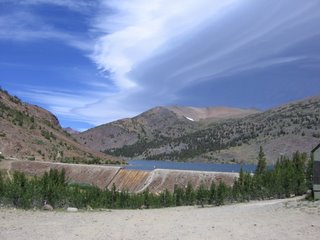 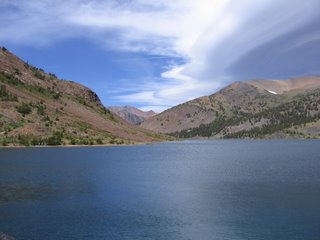 There's something almost zen about waiting for pikas. They're incredibly difficult to spot unless they're moving. So you must stare at the rock pile, searching for any hint of movement. Sometimes you can hear their calls of "peeeeek" letting you know they're in there somewhere. You stare at the rock until you become the rock. And then you see them. 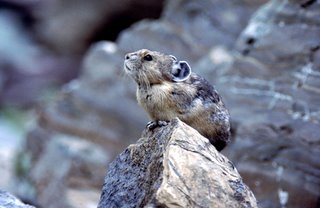 This afternoon, we weren't disappointed. A lone pika appeared, bounding across the rocks. He vanished soon after. We stayed in this amazing spot, taking in the snowy peaks around us. 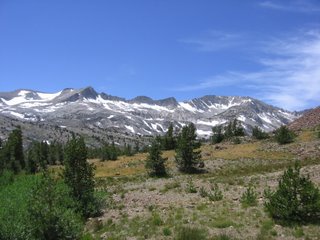 Toward sunset, we drove into Yosemite Valley, past the rushing whitewater of the Merced River. The granite edifices of El Capitan, The Three Brothers, and Half Dome towered over us. We stopped at the Ahwahnee Hotel after dinner. Built in the 1920s, the Ahwahnee is very much one of those grand National Park hotels from the earlier part of the last century. 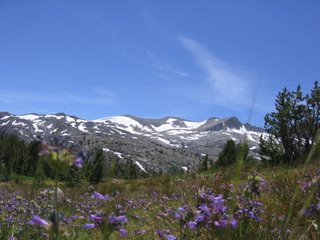 My personal favorite thing about the Ahwahnee is the phenomenal watercolor paintings of Gunnar Widforss, a Swedish artist who painted many western parks of the U.S. in the early part of the century. His stunning paintings of redwoods, Vernal Falls, Yosemite Falls, and scenic vistas of El Capitan and Half Dome capture an almost photorealistic view of these magnificent places. Widforss painted numerous views of the park in the 1920s before eventually moving to the Grand Canyon, where he painted and lived until his unexpected death at a young age. Many of his originals hang in the Ahwahnee lobby and great rooms. And what great rooms they are -- huge, high ceilinged, with medieval-looking chandeliers and stained glass windows. A tapestry hangs in the Mural Room, depicting a forest scene of bears, rabbits, and deer. After meandering through the palatial place, taking in the paintings, we returned to our campsite in the Inyo National Forest, and to another night of vivid, glittering stars. posted 2:30 AM
Monday, September 11, 2006Setting Up Camp in Inyo National Forest, Day 2
We got an amazing campsite along a burbling glacial stream in the Inyo National Forest, just east of Tioga Pass. The campsite is at 10,000 feet. The sun glitters on the stream. All around us rise tremendous snow-covered peaks. A nearby waterfall feeds the stream. We're high -- so high that not many trees remain too far above us on the mountainside. They grow shorter and shorter and then one passes above the tree line, with only rock, snow, ice, and lichens.
  At the Mono Pass trailhead, I photographed wildflowers, and saw a mariposa lily for the first time, a delicate white flower standing in a patch of sunlight in the forest. The smell of sun-warmed pine filled the forest, and patches of red Indian paintbrush, purple lupine, and vivid yellow goldenrod grew in abundance.  We continued on to deep sapphire-colored Tenaya Lake, a glacial lake west of Tioga Pass. We actually waded in the freezing water, taking in the peaks around us. Once you're numb from the cold, it's not so bad. 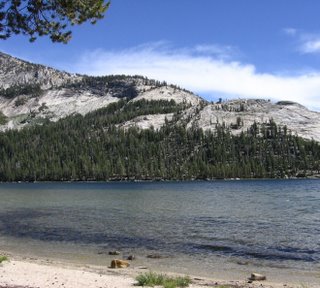 We returned to the tent, eating as the sun set golden behind the peaks. A cool wind picked up in the evening, blowing over our site. It is stunning here. Gorgeous. posted 2:45 PM
Saturday, September 09, 2006Adventure In Yosemite National Park and Inyo National Forest, Day 1
We arrived in the park at night, driving through the moonless darkness, the sky above us a sea of glittering stars. We paused at Olmstead Point, a stunning viewpoint in Yosemite which offers a view of Half Dome and the surrounding valley. For some time now, I have longed to stop here along the Tioga Pass Road, and lie down on the smooth granite domes to gaze up at the stars. This night was the perfect night. The Milky Way stretched across the entire sky.
We grabbed our warmest coats and hats and hiked a short distance up one side of a granite dome. Then we lay on the smooth, glacier-polished rock, watching meteors streak past. The sky was so dark from the utter lack of urban light pollution that I could see the Andromeda Galaxy and Lagoon Nebula with the naked eye. I brought my stargazing binoculars and took in the star-filled Double Cluster in Perseus, and clusters in Sagittarius and Scorpio. It was gorgeous. The night was a little warmer than expected, and a breeze blew over us, bringing with it the fresh scent of mountains and pine. No traffic noise, no voices, not even a bird, made it so quiet that the blood thrummed in my ears. Only the occasional passing plane broke the stupendous silence enveloping Olmstead Point. At last, reluctantly, we left the spot to secure a campsite for the evening. Pictured below is Olmstead Point as it looks in the daylight. 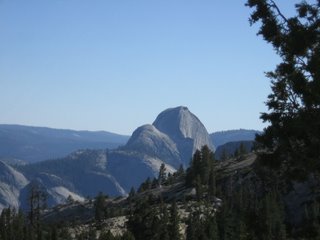 posted 3:05 PM
ArchivesApril 2005 May 2005 September 2005 November 2005 December 2005 March 2006 April 2006 May 2006 June 2006 August 2006 September 2006 October 2006 December 2006 January 2007 March 2007 April 2007 May 2007 June 2007 July 2007 August 2007 September 2007 November 2007 December 2007 January 2008 February 2008 March 2008 May 2008 June 2008 July 2008 August 2008 September 2008 October 2008 November 2008 December 2008 February 2009 March 2009 April 2009 May 2009 June 2009 July 2009 August 2009 September 2009 October 2009 February 2010 May 2010 October 2010 November 2010 February 2011 March 2011 May 2011 June 2011 July 2011 November 2011 December 2011 January 2012 February 2012 April 2012 May 2012 June 2012 July 2012 January 2013 February 2013 May 2013 April 2014 March 2018 April 2018 March 2019
|



